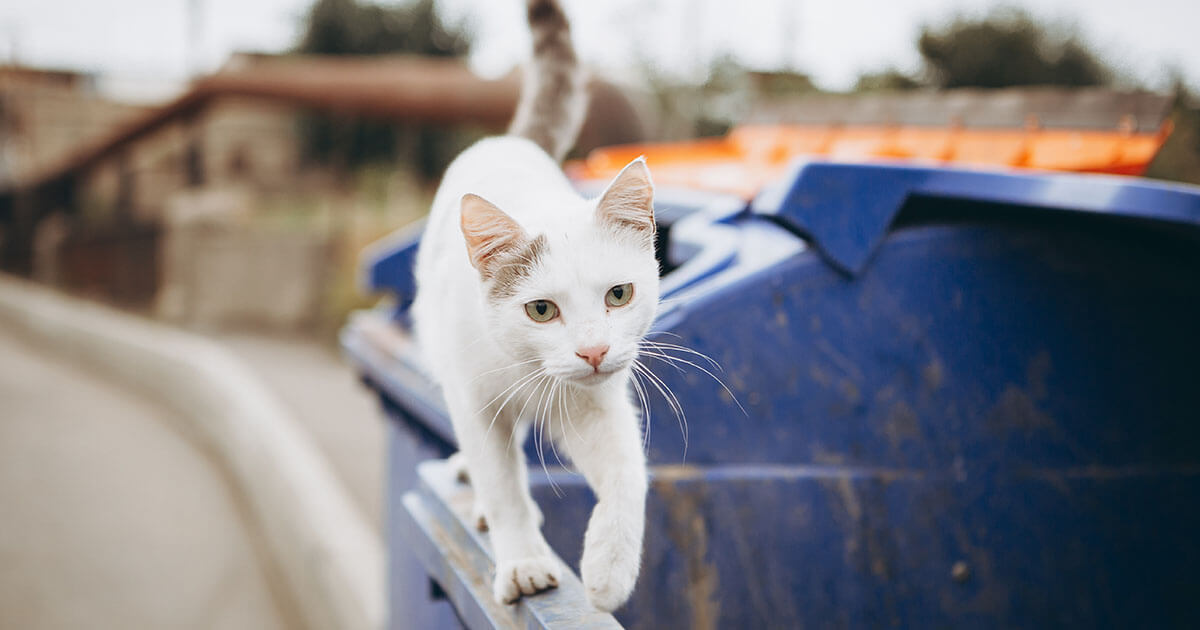Yes, a stray cat can be litter trained with patience and consistency. It often requires guidance similar to training a kitten.
Stray cats, though wilder in nature, possess the same instincts as domestic cats, including the innate desire to bury their waste. Transitioning a stray cat to a domestic life entails introducing them to a litter box, which taps into their natural inclinations.
Training begins with choosing the right litter box and litter type that a cat finds appealing. Encouraging use through positive reinforcement and placing the box in an accessible yet quiet location are key steps. This process, while sometimes challenging, ultimately helps integrate strays into a home setting, promoting a clean environment and the wellbeing of the cat. As each cat adapts at their own pace, owners should remain patient and attentive to the cat’s behavior and preferences during training.
The Potential Of Stray Cats For Home Living
Stray cats can surprise many with their ability to join a family. With patience and care, these independent animals can adapt to indoor living and become affectionate, trainable companions. Common questions arise when considering a feline street survivor for adoption, particularly about litter training. Can a stray cat shed its rugged exterior and transform into a cozy home dweller? Absolutely, and here’s how.
Adapting To A New Environment
- Introduce a quiet space with food, water, and a litter box.
- Use a consistent type of litter and box to ease transition.
- Set a routine for meals and play to create comfort.
- Allow exploration of the home in small, supervised phases.
Stray cats usually need time to understand indoor life. Present a safe and welcoming atmosphere. With these steps, a former stray starts to recognize your home as its own.
Building Trust With A Former Stray
| Step | Tips for Building Trust |
|---|---|
| 1 | Patience is key – don’t rush interactions. |
| 2 | Respect their space – let the cat come to you. |
| 3 | Use treats to encourage and reward brave behavior. |
| 4 | Gentle play can break barriers – try interactive toys. |
| 5 | Avoid loud noises – stray cats are sensitive. |
Earning a stray cat’s trust means proving you are a friend. Gentle persistence and positive reinforcement go a long way. Each small step helps cement a bond of trust, paving the way for successful litter training.

Credit: www.wired.com
Understanding Feline Bathroom Habits
Training a stray cat to use a litter box can be a unique challenge. The key lies in understanding their natural behavior. Let’s unravel the mystery of feline bathroom habits!
Natural Instincts Of Cats
Cats are private creatures with an instinct to conceal waste. Whether stray or domesticated, they share this common trait. This behavior keeps their presence hidden from predators and competitors. Cats naturally seek out sandy, loose soil for elimination. This is where a litter box comes into play.
Differences Between Stray And Domesticated Cat Behavior
Stray cats differ from their home-raised counterparts in their survival tactics. They are accustomed to the outdoors, often using a variety of spots to do their business. Domestic cats have learned to adapt their instincts to a home environment. Strays require patience and positive association to make a successful transition.
- Strays may be more cautious with unfamiliar objects, like a litter box.
- They may need a gradual introduction to the concept of an indoor toilet.
- Ensuring privacy and a quiet location aids in their comfort.
Stray cats can become excellent members of your household. With time and understanding, they can learn to use a litter box. Welcome your new furry companion with open arms and a little bit of know-how!
Essential Supplies For Litter Training
Welcome to the step-by-step guide on litter training a stray cat. Successful litter training begins with the right tools. It’s crucial to gather these supplies before the training commences.
Choosing The Right Litter Box
A proper litter box is the foundation of litter training. Consider the following when selecting a litter box:
- Size: Ensure it’s large enough for the cat to turn around comfortably.
- Height: Sides should be low for kittens or elderly cats; higher for adults to avoid litter spillage.
- Open vs. Covered: Some prefer privacy; others like open spaces. Start with an open box to observe their habits.
Selecting An Appropriate Cat Litter
The right cat litter makes all the difference. Choose litter based on:
| Type | Pros | Cons |
|---|---|---|
| Clumping | Easy to clean, long-lasting | Can be heavy and track more |
| Non-clumping | Often less expensive | Requires frequent replacement |
| Biodegradable | Eco-friendly, flushable options | May be costlier |
| Silica gel | Highly absorbent, less odor | More expensive than clay litters |
Consider the cat’s comfort and your ability to maintain cleanliness when making your choice.
Step-by-step Guide To Litter Training
Welcoming a stray cat into your home can be a heartwarming experience. Litter training is crucial for harmonious cohabitation. Rest assured, with patience, even a stray cat can embrace the comfort of a litter box. Let’s explore how you can achieve this.
Creating A Routine
Cats love routine. Establish a consistent schedule to help your feline friend adapt to using a litter box.
- Choose a quiet spot for the litter box away from the cat’s food and water.
- Show the cat the litter box by placing them in it at regular intervals, especially after meals.
- Keep the litter box clean and inviting to encourage its use.
Positive Reinforcement Techniques
Positive reinforcement speeds up the learning process. Reward good behavior to make litter training a success.
| Behavior | Reinforcement |
|---|---|
| Uses the litter box | Offer a treat or gentle praise |
| Cat shows interest in litter box | Give a comforting pet or vocal affirmation |
Stay patient and never punish the cat. This will only create fear and delay progress.
Addressing Common Challenges
Addressing common challenges with litter training a stray cat can seem daunting. Yet, with patience and the right strategies, success is within reach. Stray cats may need extra care due to their past experiences. They might not understand the purpose of a litter box right away. It is important to approach this process with understanding and flexibility.
Dealing With Accidents Outside The Litter Box
Even the most well-trained feline friends can have occasional accidents. It’s part of the learning curve. Here’s what to do when mishaps happen:
- Clean up accidents promptly using an enzyme cleaner to remove odors.
- Place the cat gently in the litter box after an accident to reinforce the correct behavior.
- Never punish your cat as this can create fear and mistrust.
- Observe patterns to determine if the accidents have an underlying cause.
Remember, consistency is key. Keep the litter box in the same easily accessible location at all times.
Managing Territorial Marking
A stray cat may mark territory, especially in a new environment. Take these steps to manage this behavior:
- Spay or neuter your cat to reduce the urge to mark.
- Use pheromone diffusers to help your cat feel secure and less inclined to mark.
- Clean marked areas well to prevent re-marking.
- Provide multiple litter boxes in different locations for added comfort.
Patience and proactive measures go a long way in acclimating your new companion.

Credit: www.amazon.com
Ensuring Long-term Success
Ensuring Long-Term Success in litter training a stray cat requires patience, consistency, and the right approach. A stray cat’s transition to an indoor lifestyle can be smooth with attention to cleanliness and the cat’s behavioral cues. Follow these steps to maintain a clean environment and understand your feline’s needs for a successful litter training experience.
Maintaining Cleanliness and HygieneMaintaining Cleanliness And Hygiene
- Choose the right litter box – Large enough for the cat to turn around.
- Regular cleaning – Scoop waste daily; wash the box weekly.
- Appropriate litter – An unscented, clumping variety often works best.
- Multiple boxes – One box per cat, plus one extra.
- Location matters – Place in a quiet, accessible area.
A clean litter box encourages use. Cats avoid dirty areas, so a tidy litter environment is crucial.
Observing Behavioral ChangesObserving Behavioral Changes
- Notice avoidance – If the cat shuns the box, it may need cleaning.
- Watch for squatting – This signals an imminent need to use the litter.
- Adjust placement – Move the box if the cat seems uncomfortable.
- Respond to accidents – Clean spots thoroughly to prevent repeat incidents.
- Seek professional advice – Persistent issues might need a vet’s intervention.
Observing a cat’s behavior closely can highlight signals leading to successful litter habits and a happy, healthy pet.

Credit: www.latimes.com
Frequently Asked Questions For Can A Stray Cat Be Litter Trained
Can You Teach A Stray Cat To Use A Litter Box?
Yes, you can train a stray cat to use a litter box. Place the cat in the box after meals and naps to encourage use. Keep the box clean and in a quiet area to make it appealing. Cats naturally prefer to eliminate in sand or soil, which a litter box mimics.
Can A Stray Cat Become A House Cat?
Yes, a stray cat can become a house cat with proper care, socialization, and time to adjust to a new indoor environment.
Is It Okay To Take Kittens From A Stray Cat?
It’s not recommended to take kittens from a stray cat without ensuring they’re abandoned or in immediate danger. Seek advice from animal welfare organizations. They can provide proper guidance on rescuing and caring for stray kittens responsibly.
Can Stray Cats Be Trained?
Yes, stray cats can be trained. It requires patience and consistency, using positive reinforcement techniques like treats and praise.
Conclusion
Embracing a feline companion from the streets doesn’t have to mean a life of litter mishaps. With patience and consistent training, stray cats can adapt to indoor living and proper litter use. It’s a journey of trust and habit building, rewarding for both pet and owner.
Open your home, guide with compassion, and watch your new friend flourish in their litter-trained life.

